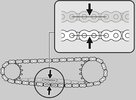- Joined
- Jun 19, 2015
- Messages
- 1,639
- Reaction score
- 626
- Points
- 113
- Location
- Surrey, BC (Canada)
I have been keeping my chain on the looser side. Another rider mentioned that it look loose. What are others keeping their slack at?
Follow along with the video below to see how to install our site as a web app on your home screen.

Note: This feature currently requires accessing the site using the built-in Safari browser.

I just tightened mine the other day. Went from 45mm to 30 mm. The manual says to keep it between 30-40 mm, and not to exceed 60 mm. Now that I have done the tightening one I likely won’t let it exceed 40mmI have been keeping my chain on the looser side. Another rider mentioned that it look loose. What are others keeping their slack at?
I do as dduelin describes, using the add 5mm method when adjustment is done on the centerstand. That puts the recommended range at 35-45 mm. I set slack for 40 mm on the centerstand, no tighter. Last fall I accidentally set it for 35 mm, but the chain sung loudly and I had to readjust to back it off to 40.Owners manual recommended 30-40mm checked on side stand.
I always check it on the center stand and keep slack measurement between 35 and 45 mm, adding 5 mm to the recommended 30-40 mm because use of center stand adds the extra amount. Because the chain will develop tight spots over time I rotate the wheel 90 degrees or so after the first measurement and check it at 3 or 4 different spots.
Measured at the midpoint between sprockets on the bottom run. Ruler vertical resting against bottom of swingarm. Push up and note measurement at center of chain pin. Pull down and note measurement at center of pin. Difference is the chain slack.Do you guys pull it down, then push it up to check chain slack or just push it up?
How about you do the legwork on your new chain.I started working in motorcycle shops in 1972 up until 1989, ( and riding and adjusting chains on motorcycles since 1965) and never saw or heard any mechanic pull down and then push up. They only pushed up from a chain at rest. Dont know if it's right or wrong, but it's the only way I have ever seen it done.
Wonder how much the difference between the two methods would really be?
I guess if you were to examine the illustration and assume it is truly realistic, the top run makes a straight line from sprocket to sprocket, indicating that it is tight. The two measurement positions of the bottom run show the chain above and below the straight line between sprockets. It seems the only way to obtain those conditions is to push up and pull down on the chain. If the chain was not pulled down for the down measurement, the top run could droop from the chain‘s weight, affecting the measurent.I've seen the graphic in the manual and it's not really clear, and certainly doesnt verbally instruct to pull down and then push up. However, it's only in the last few years that I've heard/read of pulling the chain down, and measuring up from the lowest point to the highest point.
I started working in motorcycle shops in 1972 up until 1989, ( and riding and adjusting chains on motorcycles since 1965) and never saw or heard any mechanic pull down and then push up. They only pushed up from a chain at rest. Dont know if it's right or wrong, but it's the only way I have ever seen it done.
Wonder how much the difference between the two methods would really be?

Thank you for making and reporting those measurements, MZ5.Good news! The garage is only ~95 yet!
(-:
I just did a quick check on the kickstand. I didn’t rotate the tire to check multiple points, so take this for what it’s worth.
If I push up and pull down, my chain slack is 1 3/4” at the moment. If I do _not_ pull down, but instead just let the chain fall from the pushed-up position, the slack is 1 1/2”.
So, in the particular spot on my bike’s chain where I just happened to check, and with the bike on the kickstand, I get basically 1/4” difference in slack when pushing _and_ pulling, vs. just pushing.